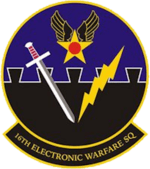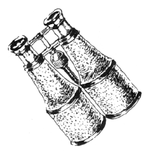16th Electronic Warfare Squadron
The 16th Electronic Warfare Squadron is an active United States Air Force unit. It is assigned to the 53d Electronic Warfare Group at Eglin Air Force Base, Florida. It was formed in 1985 by the consolidation of three units.
| 16th Electronic Warfare Squadron | |
|---|---|
| Active | 1917–1919; 1921–1945; 1947–1949; 1993–present |
| Country | |
| Branch | |
| Type | Test and evaluation |
| Commanders | |
| Notable commanders | General of the Air ForceHenry H. Arnold (1926–28) |
| Insignia | |
| 16th Electronic Warfare Squadron emblem |  |
The 16th Aero Squadron, a World War I squadron that provided maintenance support for aeronautical units on the Western Front.
The 16th Reconnaissance Squadron, which served during the years between the World Wars as an observation squadron, with its flights located with various Army schools. During World War II, the squadron served in the Mediterranean, where it was awarded a Distinguished Unit Citation for its performance from October 1943 to January 1944.
The 16th Photographic Reconnaissance Squadron, which served as a long range photographic unit during the early years of the Cold War.
Mission
The 16th Electronic Warfare Squadron (EWS) provides electronic warfare test facilities for mission data and electronic warfare systems test and evaluation. Its personnel assess the maintainability, reliability, suitability, and readiness of electronic warfare systems and support equipment, and perform test and evaluation of new concepts for electronic warfare systems. They also monitor developmental testing conducted by acquisition agencies. The 16th EWS develops, fabricates and maintains test instrumentation and performs acceptance tests of all new electronic warfare related hardware and software and supports training for maintenance and operational units worldwide. The squadron also provides technicians and equipment to execute the COMBAT SHIELD Electronic Warfare Assessment Program. The 16th EWS has more than $450 million in assets, including eight system integration laboratories and five mobile test facilities.[1]
Detachment 1 of the 16 EWS is located at Tyndall AFB, Florida and provides maintenance support for adversary electronic attack training pods used for air-to-air electronic warfare training. These pods are repaired and modified at Tyndall AFB and shipped to fighter units worldwide. Det 1, 16 EWS also maintains electronic attack payloads for full-scale and subscale drones in support of live-fire missile testing under the COMBAT ARCHER Weapon System Evaluation Program.[1]
History
The squadron was originally established as an Air Service flying training unit in May 1917, conducting flying training for air cadets in the Midwest throughout the summer. It deployed to France in January 1918, becoming an aircraft maintenance organization in rear areas of the Western Front. It remained in France until May 1919 when squadron returned to the United States and demobilized.[2]

The 16th Squadron was established in 1921 as an observation squadron, attached to Army ground units throughout the 1920s and 1930s. It was consolidated with its predecessor in 1924. The 16th carried mail and performed fire observation duties, included carrying mail to President Calvin Coolidge vacationing in South Dakota and Wisconsin in August and September 1927, and June to September 1928.[2]
After the Attack on Pearl Harbor the squadron was reassigned to antisubmarine duties along the southeast coast in late 1941, early 1942. It deployed to the European Theater of Operations, where it was attached to the Royal Air Force reconnaissance school at RAF Wattisham, England in late 1942. While in England, the air echelon received modern Lockheed P-38 long-range photo-reconnaissance aircraft and joined the ground personnel in French Morocco shortly after the Operation Torch invasion in November 1942.
The squadron was assigned to Twelfth Air Force and engaged in long range intelligence gathering and aerial mapping of Algeria and Tunisia, supporting the United States Fifth Army during the North African and Tunisian Campaigns. After the retreat of Axis forces from Tunisia in mid-1942, performed antisubmarine patrols over the Mediterranean Sea and also functioned as in in-theater training unit for aerial reconnaissance pilots.[2]
Beginning in September 1943, the squadron received specially-equipped B-17 Flying Fortress heavy bombers equipped with radar detection and electronic countermeasures (ECM) equipment.[2] It performed ECM overflights of enemy territory in advance of Fifteenth Air Force heavy bomber formations, jamming enemy Radar and generating false returns to confuse defensive forces. It also continued to fly long range reconnaissance with B-25 Mitchell medium bombers fitted with aerial cameras.. The Squadron returned to the United States in November 1944 as the need for the unit dissipated as enemy forces were driven out of the Mediterranean Theater of Operations. It was inactivated in April 1945.[2]
The 16th Photographic Reconnaissance Squadron served with Strategic Air Command as a long-range reconnaissance unit early in the Cold War. Its mission was absorbed by the 91st Strategic Reconnaissance Wing in 1949. In 1985, it was consolidated with its predecessors,[3] but remained inactive until 1993, when it assumed its present mission.
Lineage
16th Aero Squadron
- Organized as 3d Aviation School Squadron on 9 May 1917
- Redesignated 16th Aero Squadron (Construction) on 31 Aug 1917
- Redesignated 16th Aero Squadron (Repair) 1918
- Demobilized on 22 May 1919
- Reconstituted and consolidated with 16th Observation Squadron as 16th Observation Squadron on 8 April 1924[2]
16th Reconnaissance Squadron
- Authorized as 16th Squadron (Observation) on 30 August 1921
- Organized on 7 Dec 1921
- Redesignated 16th Observation Squadron (Corps and Army) on 25 Jan 1923
- Consolidated with 16th Aero Squadron on 8 April 1924
- Inactivated on 15 Mar 1931
- Flights remained active:
- A Flight at Langley Field, Virginia (attached to Air Corps Tactical School)
- B Flight at Lawson Field, Georgia (attached to Infantry School)
- C Flight at Pope Field, North Carolina
- D Flight at Marshall Field, Kansas (attached to Command and General Staff School)
- E Flight at Post Field, Oklahoma (attached to Field Artillery School)
- Activated on 1 Jun 1937
- Redesignated 16th Observation Squadron (Medium) on 13 Jan 1942
- Redesignated 16th Observation Squadron on 4 Jul 1942
- Redesignated 16th Reconnaissance Squadron (Bomber) on 31 May 1943
- Redesignated 16th Reconnaissance Squadron, Heavy (Special) on 12 May 1944
- Disbanded on 12 Apr 1945[2]
- Reconstituted on 19 September 1985 and consolidated with 16th Photographic Reconnaissance Squadron as 16th Tactical Electronic Warfare Squadron[3]
16th Photographic Reconnaissance Squadron
- Constituted as 16th Photographic Reconnaissance Squadron (Special) 1947
- Activated on 16 December 1947
- Inactivated on 1 June 1949
- Consolidated on 19 September 1985 with 16th Reconnaissance Squadron as 16th Tactical Electronic Warfare Squadron[3]
16th Electronic Warfare Squadron
- Formed on 19 September 1985 by consolidation of 16th Reconnaissance Squadron and 16th Photographic Reconnaissance Squadron
- Redesignated 16th Test Squadron
- Activated on 15 April 1993.
- Redesignated 16th Electronic Warfare Squadron unknown
Assignments
|
|
Stations
|
|
Aircraft
- JN-4, 1917
- In addition to DH-4, c. 1922–1926, and 0–2, 1926¬1930
- Included JNS-1, 0-1, and apparently JN-4 and JN-6 during period 1921–1930; 0-25, 1930–1931
- O-46, 1937-C. 1939, 0-47, 1938–1942, and 0-49, 1941–1942
- YG-1, and 0-43 during period 1937–1940
- 0-51 and 0-9 during period 1940–1941
- DB-7, L-4, P-40, and P-43 during 1942
- A-20 and P-39, 1942–1943
- P-38, P-39, P-40, and Spitfire, 1943
- Primarily B-17, 1943–1944
- B-25, 1945
References
Notes
- Eglin AFB Factsheet, 53d Wing Archived 2010-12-27 at the Wayback Machine 5/9/2013 (retrieved 20 May 2013)
- Maurer, Maurer, ed. (1982) [1969]. Combat Squadrons of the Air Force, World War II (PDF) (reprint ed.). Washington, DC: Office of Air Force History. pp. 90–92. ISBN 0-405-12194-6. LCCN 70605402. OCLC 72556.
- Department of the Air Force/MPM Letter 662q, 19 Sep 85, Subject: Reconstitution, Redesignation, and Consolidation of Selected Air Force Tactical Squadrons
- Station Number in Anderson, Capt. Barry (1985). Army Air Forces Stations: A Guide to the Stations Where U.S. Army Air Forces Personnel Served in the United Kingdom During World War II (PDF). Maxwell AFB, AL: Research Division, USAF Historical Research Center. Archived from the original (PDF) on 23 January 2016. Retrieved 7 July 2012.
Bibliography
![]()
- Anderson, Capt. Barry (1985). Army Air Forces Stations: A Guide to the Stations Where U.S. Army Air Forces Personnel Served in the United Kingdom During World War II (PDF). Maxwell AFB, AL: Research Division, USAF Historical Research Center. Archived from the original (PDF) on 23 January 2016. Retrieved 7 July 2012.
- Maurer, Maurer, ed. (1982) [1969]. Combat Squadrons of the Air Force, World War II (PDF) (reprint ed.). Washington, DC: Office of Air Force History. ISBN 0-405-12194-6. LCCN 70605402. OCLC 72556.